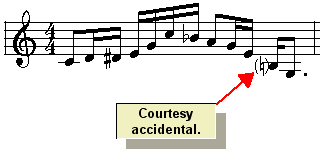|
<< Click to Display Table of Contents >> Accidental (Sharp, Flat, etc.) |
  
|
|
<< Click to Display Table of Contents >> Accidental (Sharp, Flat, etc.) |
  
|
You can change the pitch of a note by adding or removing an accidental. You can also change the enharmonic spelling of a note, such as from C# to Db, which raises or lowers the position of the note on the staff by a half-space, but leaves the pitch unchanged.
Composer automatically determines the spellings of notes, based on the key signature and surrounding harmony. Composer usually makes the correct decision about the enharmonic spelling of a note as, for example, Db versus C#. In some cases, however, Composer may make a mistake, or you may have a different opinion about the correct spelling. In such cases, you can override Composer's choice of spelling, as described in the second procedure below.
TIP: When you change the pitches of notes, we recommend that you let Composer make a first guess at the spelling. For example, If you want to raise the pitch of a note by a half-step, then select the note and hit the P+![]() keys, Try this instead of, for example, dragging the note to the staff position above and explicitly inserting a flat accidental. Why? If you explicitly add the flat accidental, Composer will rigidly preserve that spelling of the note with a flat accidental. Even if you radically change the surrounding notes to sharps, this note will continue to be spelled with a flat, probably incorrectly, rather than with a sharp at the next lower staff line.
keys, Try this instead of, for example, dragging the note to the staff position above and explicitly inserting a flat accidental. Why? If you explicitly add the flat accidental, Composer will rigidly preserve that spelling of the note with a flat accidental. Even if you radically change the surrounding notes to sharps, this note will continue to be spelled with a flat, probably incorrectly, rather than with a sharp at the next lower staff line.
![]() To change the accidental and corresponding pitch of a note:
To change the accidental and corresponding pitch of a note:
| 1. | Select the note by clicking it with the mouse. |
| 2. | Choose one of the accidentals in the Accidental submenu of the Note menu. |
-- OR --
Type one of the following commands, which is easier than using the Note menu:
Keyboard Command |
Accidental |
"ss" or "#" |
sharp |
"f" or "b" |
flat |
"na" |
no accidental |
"ds" or "d#" or "x" |
double sharp |
"df" or "db" |
double flat |
![]() To change the enharmonic spelling of a note:
To change the enharmonic spelling of a note:
| 1. | Select the note by clicking it with the mouse. |
| 2. | In the Enharmonic Spelling submenu of the Note menu, choose the Raise or Lower command. |
-- OR --
Type E+![]() (or E+
(or E+![]() ) to raise (or lower) the enharmonic ("E") spelling. To "raise" the enharmonic spelling means to "move the note up one step on the staff". For example, Db is the raised enharmonic spelling for C#, because D is one step higher on the staff than C.
) to raise (or lower) the enharmonic ("E") spelling. To "raise" the enharmonic spelling means to "move the note up one step on the staff". For example, Db is the raised enharmonic spelling for C#, because D is one step higher on the staff than C.
The following table illustrates the Raise and Lower Enharmonic Spelling commands:
Original Spelling |
Raise Enharmonic Spelling |
Lower Enharmonic Spelling |
C |
Dbb |
B# |
C# |
Db |
B## |
Db |
not available |
C# |
D# |
Eb |
not available |
F |
Gbb |
E# |
A "courtesy accidental" is an accidental that does not need to be displayed because it is already implied by the key signature or a preceding identical accidental in the same measure. The courtesy accidental is displayed to help the performer avoid possibly overlooking the accidental, or to assure the performer that the accidental is intended by the composer. A courtesy accidental is displayed in parentheses, as illustrated below:

![]() To add a courtesy accidental:
To add a courtesy accidental:
| 1. | Select the note for which you wish to add the courtesy accidental. |
| 2. | Type the parenthesis character '('. |
-- OR --
Type "ca" for courtesy accidental.
Composer will add the implied accidental with parentheses around it, as illustrated above.
![]() To remove a courtesy accidental:
To remove a courtesy accidental:
| 1. | Select the note that has a courtesy accidental (with parentheses around it). |
| 2. | Type "rc" for remove courtesy accidental. |